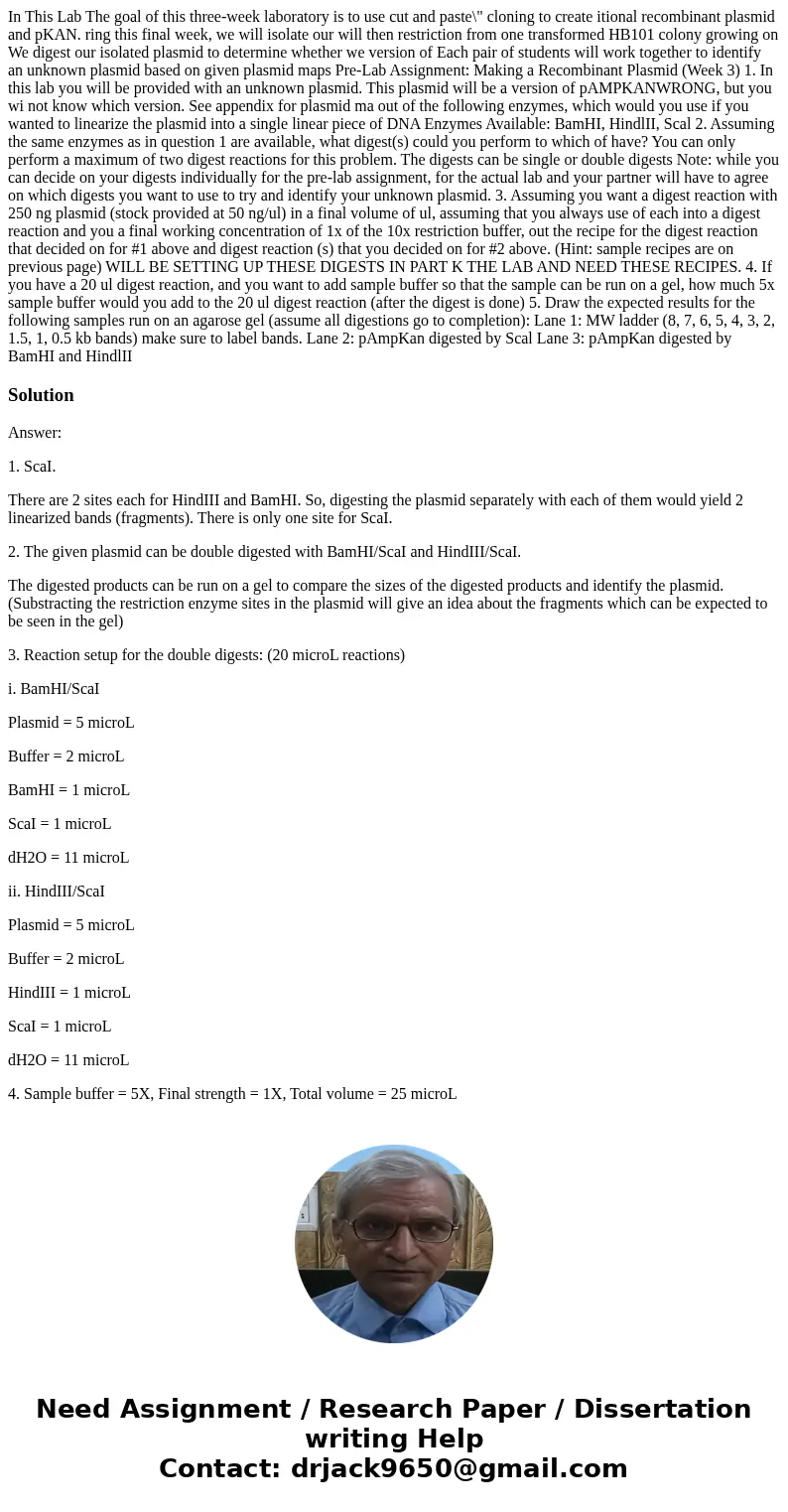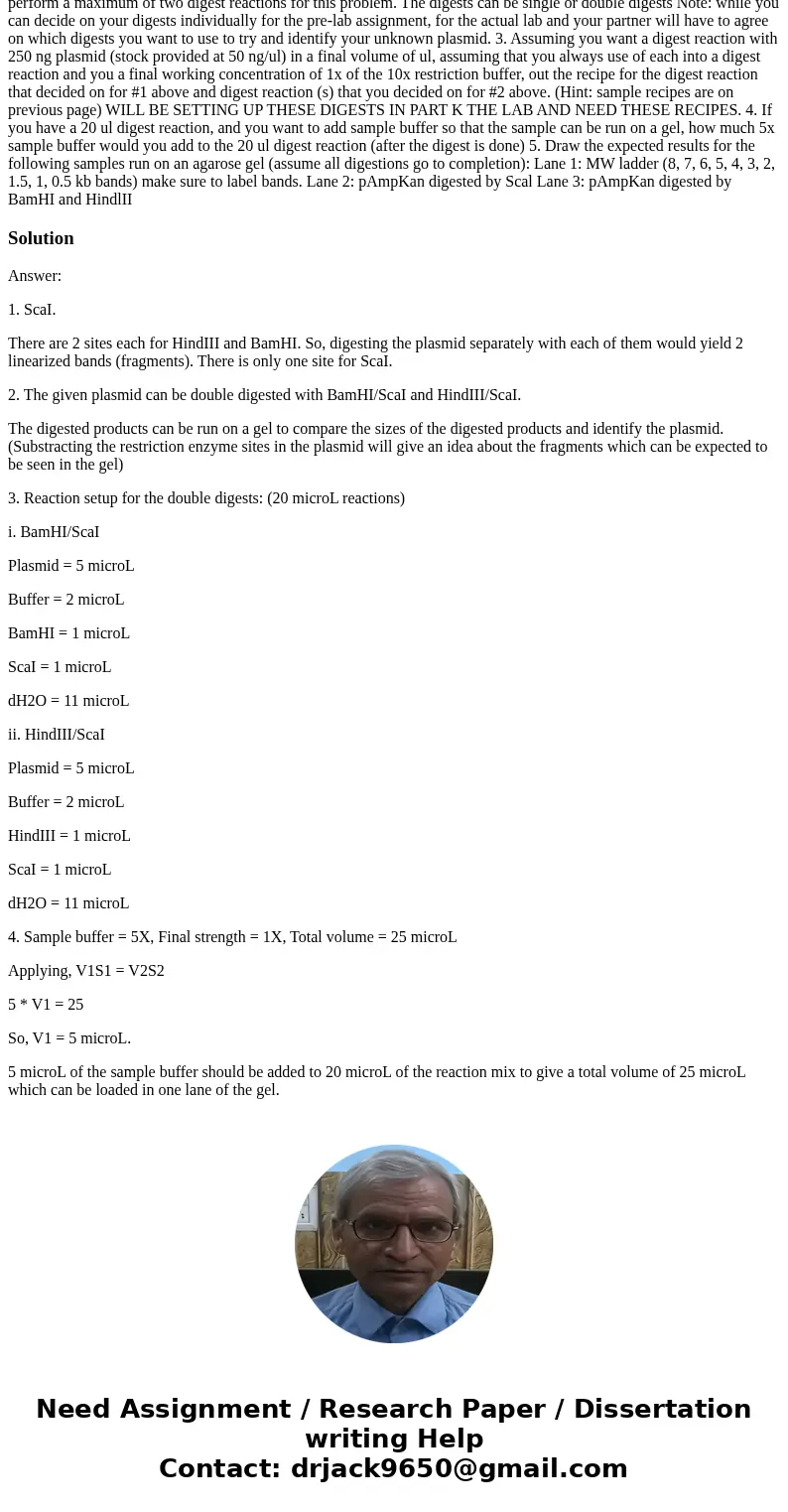In This Lab The goal of this three-week laboratory is to use cut and paste\" cloning to create itional recombinant plasmid and pKAN. ring this final week, we will isolate our will then restriction from one transformed HB101 colony growing on We digest our isolated plasmid to determine whether we version of Each pair of students will work together to identify an unknown plasmid based on given plasmid maps Pre-Lab Assignment: Making a Recombinant Plasmid (Week 3) 1. In this lab you will be provided with an unknown plasmid. This plasmid will be a version of pAMPKANWRONG, but you wi not know which version. See appendix for plasmid ma out of the following enzymes, which would you use if you wanted to linearize the plasmid into a single linear piece of DNA Enzymes Available: BamHI, HindlII, Scal 2. Assuming the same enzymes as in question 1 are available, what digest(s) could you perform to which of have? You can only perform a maximum of two digest reactions for this problem. The digests can be single or double digests Note: while you can decide on your digests individually for the pre-lab assignment, for the actual lab and your partner will have to agree on which digests you want to use to try and identify your unknown plasmid. 3. Assuming you want a digest reaction with 250 ng plasmid (stock provided at 50 ng/ul) in a final volume of ul, assuming that you always use of each into a digest reaction and you a final working concentration of 1x of the 10x restriction buffer, out the recipe for the digest reaction that decided on for #1 above and digest reaction (s) that you decided on for #2 above. (Hint: sample recipes are on previous page) WILL BE SETTING UP THESE DIGESTS IN PART K THE LAB AND NEED THESE RECIPES. 4. If you have a 20 ul digest reaction, and you want to add sample buffer so that the sample can be run on a gel, how much 5x sample buffer would you add to the 20 ul digest reaction (after the digest is done) 5. Draw the expected results for the following samples run on an agarose gel (assume all digestions go to completion): Lane 1: MW ladder (8, 7, 6, 5, 4, 3, 2, 1.5, 1, 0.5 kb bands) make sure to label bands. Lane 2: pAmpKan digested by Scal Lane 3: pAmpKan digested by BamHI and HindlII
Answer:
1. ScaI.
There are 2 sites each for HindIII and BamHI. So, digesting the plasmid separately with each of them would yield 2 linearized bands (fragments). There is only one site for ScaI.
2. The given plasmid can be double digested with BamHI/ScaI and HindIII/ScaI.
The digested products can be run on a gel to compare the sizes of the digested products and identify the plasmid. (Substracting the restriction enzyme sites in the plasmid will give an idea about the fragments which can be expected to be seen in the gel)
3. Reaction setup for the double digests: (20 microL reactions)
i. BamHI/ScaI
Plasmid = 5 microL
Buffer = 2 microL
BamHI = 1 microL
ScaI = 1 microL
dH2O = 11 microL
ii. HindIII/ScaI
Plasmid = 5 microL
Buffer = 2 microL
HindIII = 1 microL
ScaI = 1 microL
dH2O = 11 microL
4. Sample buffer = 5X, Final strength = 1X, Total volume = 25 microL
Applying, V1S1 = V2S2
5 * V1 = 25
So, V1 = 5 microL.
5 microL of the sample buffer should be added to 20 microL of the reaction mix to give a total volume of 25 microL which can be loaded in one lane of the gel.


 Homework Sourse
Homework Sourse